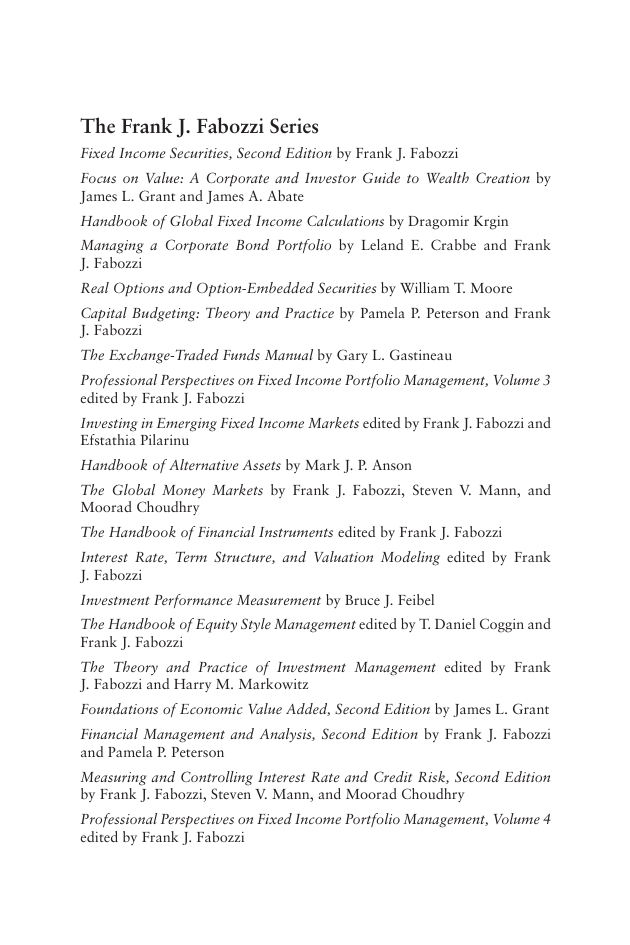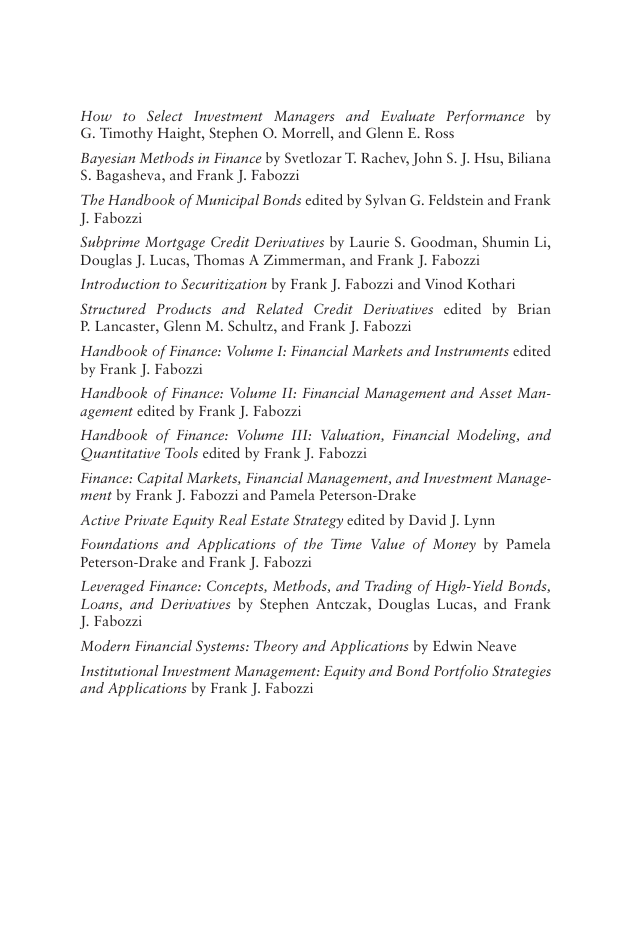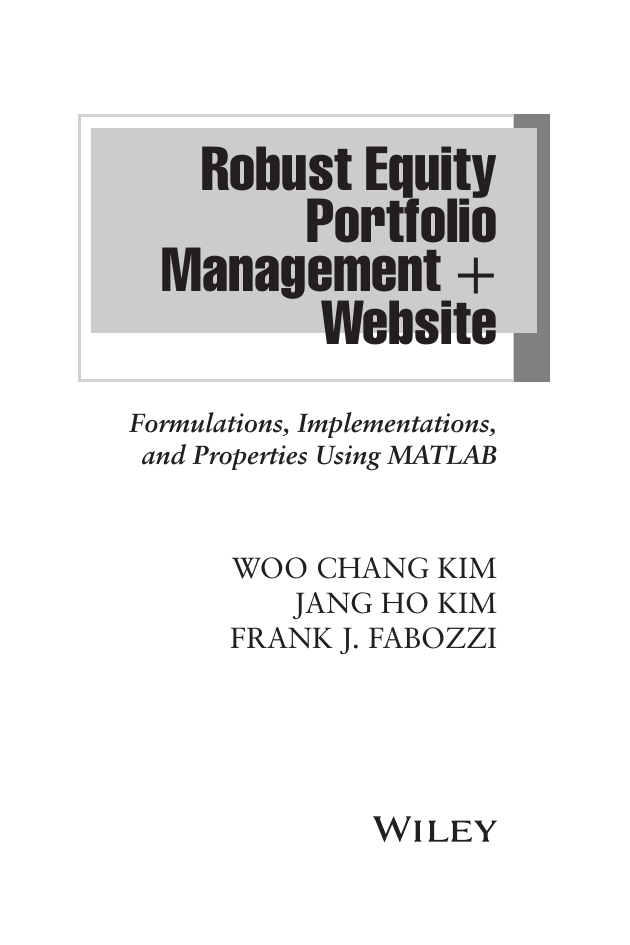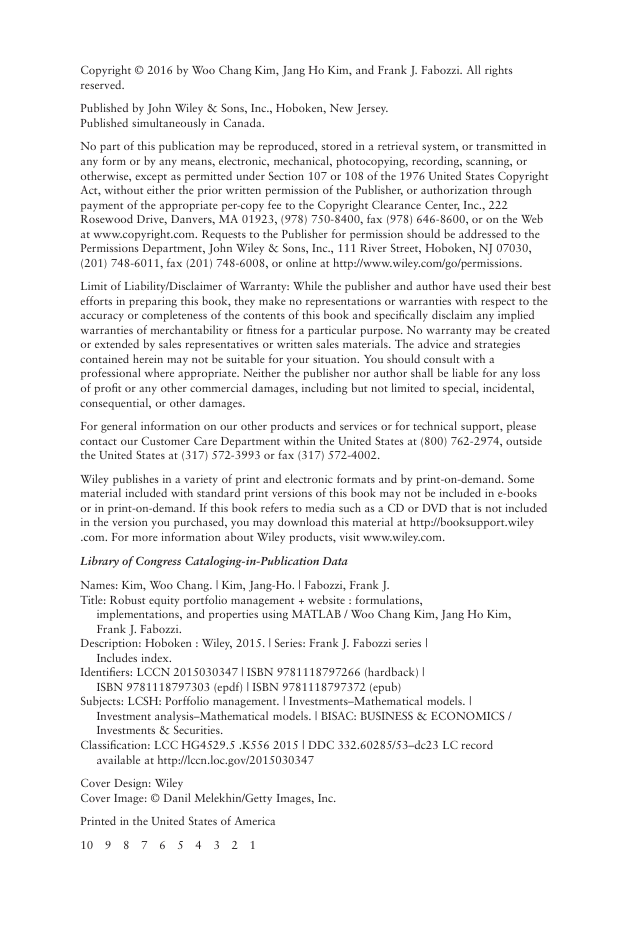Cover
Title Page
Copyright
Contents
Preface
Chapter 1 Introduction
1.1 Overview of the Chapters
1.2 Use of MATLAB
Notes
Chapter 2 Mean-Variance Portfolio Selection
2.1 Return of Portfolios
2.2 Risk of Portfolios
2.3 Diversification
2.4 Mean-Variance Analysis
2.5 Factor Models
2.6 Example
Key Points
Notes
Chapter 3 Shortcomings of Mean-Variance Analysis
3.1 Limitations on the Use of Variance
3.2 Difficulty in Estimating the Inputs
3.3 Sensitivity of Mean-Variance Portfolios
3.4 Improvements on Mean-Variance Analysis
Key Points
Notes
Chapter 4 Robust Approaches for Portfolio Selection
4.1 Robustness
Uncertainty Aversion
4.2 Robust statistics
Mean vs. Median
M-Estimators
L-Estimators
Estimators of Dispersion
4.3 Shrinkage Estimation
4.4 Monte Carlo Simulation
Portfolio Resampling
4.5 Constraining Portfolio Weights
4.6 Bayesian Approach
Black-Litterman Model
Equilibrium Model
Views of Investors
Combining the Equilibrium State with Investors’ Views
4.7 Stochastic Programming
4.8 Additional Approaches
Key Points
Notes
Chapter 5 Robust Optimization
5.1 Worst-Case Decision Making
5.2 Convex Optimization
Duality
Linear Programming
Quadratic Programming
Conic Programming
Second-Order Cone Programming
Semidefinite Programming
5.3 Robust Counterparts
Uncertainty Sets
Robust Linear Programming
5.4 Interior Point Methods
Key Points
Notes
Chapter 6 Robust Portfolio Construction
6.1 Some Preliminaries
6.2 Mean-Variance Portfolios
6.3 Constructing Robust Portfolios
6.4 Robust Portfolios with Box Uncertainty
Step 1. Formulate the Robust Problem by Defining the Box Uncertainty Set
Step 2. Reformulate the Robust Counterpart with Box Uncertainty
Step 3. Use Optimization Tools to Solve the Box Uncertainty Problem
6.5 Robust Portfolios with Ellipsoidal Uncertainty
Step 1. Formulate the Robust Problem by Defining the Ellipsoidal Uncertainty Set
Step 2. Reformulate the Robust Counterpart with Ellipsoidal Uncertainty
Step 3. Use Optimization Tools to Solve the Ellipsoidal Uncertainty Problem
6.6 Closing Remarks
Key Points
Notes
Chapter 7 Controlling Third and Fourth Moments of Portfolio Returns via Robust Mean-Variance Approach
7.1 Controlling Higher Moments of Portfolio Return
7.2 Why Robust Formulation Controls Higher Moments
7.3 Empirical Tests
Key Points
Notes
Chapter 8 Higher Factor Exposures of Robust Equity Portfolios
8.1 Importance of Portfolio Factor Exposure
8.2 Fundamental Factor Models in the Equity Market
8.3 Factor Dependency of Robust Portfolios: Theoretical Arguments
8.4 Factor Dependency of Robust Portfolios: Empirical Findings
8.5 Factor Movements and Robust Portfolios
8.6 Robust Formulations That Control Factor Exposure
Key Points
Notes
Chapter 9 Composition of Robust Portfolios
9.1 Overview of Analyses
9.2 Composition Based on Investment Styles
9.3 Composition Based on Additional Factors
9.4 Composition Based on Stock Betas
9.5 Robust Portfolio Construction Based on Stock Beta Attributes
Key Points
Notes
Chapter 10 Robust Portfolio Performance
10.1 Portfolio Performance Measures
Holding Period Return
Annual Return (Annualized Return)
Volatility (Standard Deviation)
Sharpe Ratio
Alpha and Beta
Tracking Error
Information Ratio
Sortino Ratio
Maximum Drawdown
Value-at-Risk
Conditional Value-at-Risk
10.2 Historical Performance of Robust Portfolios
Portfolio Strategies
Data Description and Rebalancing Method
Performance from 1981 to 2013
Performance during the Global Financial Crisis
10.3 Measuring Robustness
Key Points
Notes
Chapter 11 Robust Optimization Software
11.1 Yalmip
Basic Structure
Uncertain Variables
Examples
11.2 ROME (Robust Optimization Made Easy)
Basic Structure
Uncertain Variables
Example
11.3 AIMMS
Key Points
Notes
About the Authors
About the Companion Website
Index
EULA
















 2023年江西萍乡中考道德与法治真题及答案.doc
2023年江西萍乡中考道德与法治真题及答案.doc 2012年重庆南川中考生物真题及答案.doc
2012年重庆南川中考生物真题及答案.doc 2013年江西师范大学地理学综合及文艺理论基础考研真题.doc
2013年江西师范大学地理学综合及文艺理论基础考研真题.doc 2020年四川甘孜小升初语文真题及答案I卷.doc
2020年四川甘孜小升初语文真题及答案I卷.doc 2020年注册岩土工程师专业基础考试真题及答案.doc
2020年注册岩土工程师专业基础考试真题及答案.doc 2023-2024学年福建省厦门市九年级上学期数学月考试题及答案.doc
2023-2024学年福建省厦门市九年级上学期数学月考试题及答案.doc 2021-2022学年辽宁省沈阳市大东区九年级上学期语文期末试题及答案.doc
2021-2022学年辽宁省沈阳市大东区九年级上学期语文期末试题及答案.doc 2022-2023学年北京东城区初三第一学期物理期末试卷及答案.doc
2022-2023学年北京东城区初三第一学期物理期末试卷及答案.doc 2018上半年江西教师资格初中地理学科知识与教学能力真题及答案.doc
2018上半年江西教师资格初中地理学科知识与教学能力真题及答案.doc 2012年河北国家公务员申论考试真题及答案-省级.doc
2012年河北国家公务员申论考试真题及答案-省级.doc 2020-2021学年江苏省扬州市江都区邵樊片九年级上学期数学第一次质量检测试题及答案.doc
2020-2021学年江苏省扬州市江都区邵樊片九年级上学期数学第一次质量检测试题及答案.doc 2022下半年黑龙江教师资格证中学综合素质真题及答案.doc
2022下半年黑龙江教师资格证中学综合素质真题及答案.doc